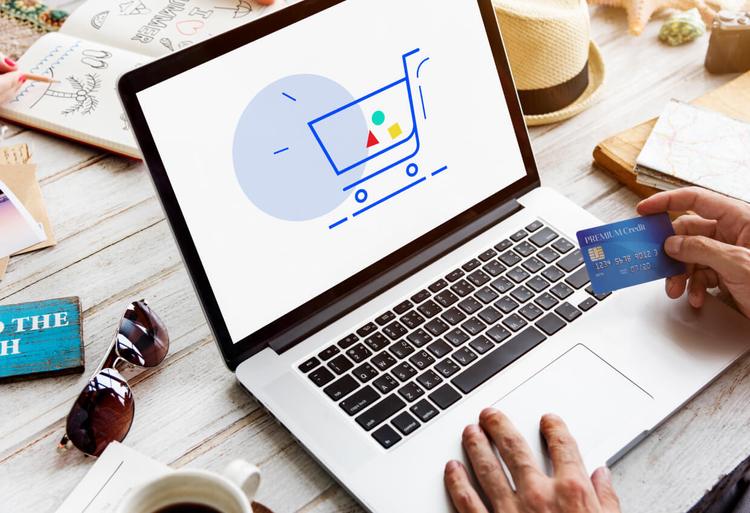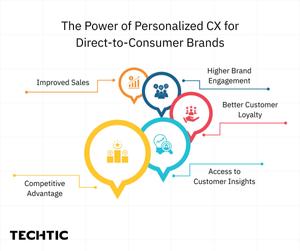Power of Personalization in Delivering Superior CX in D2C
Sector: Digital Commerce
Author: Nisarg Mehta
Date Published: 01/25/2024

Contents
- What Does Personalization Mean in the D2C E-Commerce Environment?
- Benefits of CX Personalization for D2C Brands
- AI Is Essential for Personalizing CX for D2C
- Road to Personalizing Customer Experience for E-Commerce
- Dynamic Pricing Strategies
- Predictive Analytics for Inventory Management
- Intelligent Product Recommendation
- Continue Shopping for Returning Customers
- Semantic Search to Narrow-Down Options
- Personalization of Best Sellers List
- Integration of UGC Across the Funnel
- Retarget Customers In-Session Based on Behavioral Triggers
- Retargeting Ads Across Customer Touchpoints
- Email and Text Communication Personalization
- CX Personalization is Your Key to Success
E-commerce has long pursued personalization, aiming for real-time, multi-platform customization tailored to customer preferences.
Fortunately, digital commerce now has access to these technologies. The challenge lies in the plethora of available technologies, each offering varying degrees of personalization.
This makes it hard to define and implement effective personalized user experiences in e-commerce. This article delves into CX personalization within the direct-to-customer e-commerce landscape, covering essential aspects you need to know.
What Does Personalization Mean in the D2C E-Commerce Environment?
E-commerce personalization involves tailoring the online shopping experience using individual customer data. This customization is driven by various factors, including browsing history, demographic information, previous purchases, and the device used for browsing.
McKinsey’s research highlights the impact of personalization, revealing up to a 15% boost in conversion rates and a 20% increase in customer satisfaction, both crucial for customer retention.
Retaining customers is particularly important, as businesses that increase retention by 5 percent see profits increase between 25% and 95%. You, as a retailer, will find it more economical as well since it is between 5 and 25 percent more costly to acquire new customers than to retain current ones.
Achieving CX personalization with low-to-mid SKU counts and customer base is simple. However, when those numbers jump into the hundreds of thousands and beyond, finding a simple yet profitable solution can be overwhelming.
Benefits of CX Personalization for D2C Brands
Before digital commerce became prevalent, shopping was straightforward. Customers would visit physical stores and rely on helpful staff to find what they needed. This process was direct and personal.

Unfortunately, that kind of individual customer care is still highly unusual in digital commerce. Even though retailers, brands, and B2B companies continually emphasize the importance of delivering a personalized customer experience, personalization is rarely implemented.
Let’s examine the advantages of personalization in e-commerce.
Improved Sales
In e-commerce, standard stores may not sufficiently engage customers to drive purchases. Personalized e-commerce, however, can effectively encourage buying by showcasing precisely what customers seek.
Utilizing product recommendations during checkout, brands can spotlight items more likely to appeal to specific customer groups. This strategy can enhance the conversion rate of products not universally popular, tailoring the shopping experience to individual preferences.
Higher Brand Engagement
Understanding customers’ preferred shopping locations and items can significantly increase their engagement with your brand. Personalization draws consumers by displaying products they are interested in, in a format they prefer, fostering a deeper connection with your brand.
Better Customer Loyalty
Personalized e-commerce experiences foster greater loyalty. By showing customers you understand their preferences, they’re more inclined to stay loyal to your brand over competitors.
Access to Customer Insights
E-commerce personalization offers critical insights into customer preferences. Collecting and analyzing consumer data—like location, preferred products, and dislikes—enables companies to tailor their offerings more effectively, deciding which products to continue selling and which to phase out.
Competitive Advantage
Leveraging e-commerce personalization can put you ahead of competitors. In a landscape where customer preferences rapidly change, providing a uniquely personalized experience increases the likelihood of customers staying loyal to your brand, potentially turning them into brand advocates.
AI Is Essential for Personalizing CX for D2C
AI and machine learning are pivotal in evolving customer experience personalization, especially for direct-to-consumer (D2C) businesses. These technologies enable real-time assistance and tailored experiences, previously unachievable with manual methods.
AI’s ability to quickly process vast amounts of data is essential for real-time customer interaction optimization. In the D2C sector, where customer preferences constantly shift, AI’s agility in adapting to these changes is crucial. It analyzes data like browsing habits, purchase history, and engagement to discern individual preferences and predict needs.
The scalability of AI and machine learning is also crucial. They manage growing interaction volumes without quality loss, ensuring that as a D2C business expands, its capacity for delivering personalized experiences stays efficient.
Beyond basic product recommendations, AI in the D2C realm enables hyper-personalized experiences, making customers feel uniquely catered to. AI can suggest products matching a customer’s style, size, and ethical preferences, making each interaction distinct and personal.
Moreover, the continuous learning aspect of machine learning means these systems improve over time, refining their understanding of customer preferences for more accurate, relevant recommendations. This ongoing enhancement is vital for sustaining customer engagement and satisfaction.
Road to Personalizing Customer Experience for E-Commerce
Personalization in e-commerce is diverse and multifaceted. Here are several key approaches:
1. Dynamic Pricing Strategies
AI algorithms can analyze data related to customer demand, competitor pricing, market trends, and individual customer’s purchasing history as well as behavior. This helps online retailers like you to adjust the prices of your products in real time.
With this approach, frequent buyers or those with a high lifetime value could be offered special discounts, while new visitors might see introductory prices. This can significantly improve customer loyalty and satisfaction.
2. Predictive Analytics for Inventory Management
Predictive analytics algorithms, powered by AI can revolutionize inventory management in e-commerce. By forecasting future product demand based on historical sales data, current market trends, and consumer behavior patterns, AI can help online retailers businesses optimize their inventory levels.
This means having the right products available at the right time, reducing the risk of stockouts or overstock situations. Moreover, it can personalize the customer experience by ensuring that popular items among specific customer segments are always in stock.
This proactive approach to inventory management not only improves operational efficiency but also contributes to a more seamless and satisfying shopping experience for customers.
3. Intelligent Product Recommendation
On the product detail page (PDP), you can show shoppers similar or related items to the ones they’re already considering. You can upsell by suggesting items of a higher price but a similar style or brand or by recommending items of a lower price but a similar style or brand. Typically, they are the ones with higher profit margins and the highest conversion rates.
By using cross-selling on PDPs, retailers can increase the likelihood that customers will purchase complementary items and increase their shopping cart value.
In addition to providing a better shopping experience for your customers, intelligent product recommendations have been shown to improve conversion rates and average order values.
4. Continue Shopping for Returning Customers
The “keep watching” feature is one of the most significant elements of Netflix’s user experience. When we saw this, we knew we could utilize it in e-commerce for our clients.
This approach remembers your visitors’ preferred items and preferences from previous sessions and makes it simpler for them to continue where they left off. Although this algorithm is not particularly complex, it is valuable because it makes purchasing simpler for your customers.
5. Semantic Search to Narrow-Down Options
Personalized searching is significantly important, as visitors who use search convert at a higher rate than typical visitors.
However, despite the importance of the search bar, search functions may have a detrimental effect on user experience because many e-commerce search engines emphasize keywords rather than their meaning.
You have to consider that search can be a struggle when it comes to getting accurate results. Customers tend to use broad terms, make spelling mistakes, and describe the same product differently.
In such cases, having intelligent search with semantic understanding capabilities is a big advantage. Regarding selling, brands, manufacturers, retailers, and distributors must deliver an intelligent search experience to guide customers.
For example, when a user that has expressed interest in female items (for example, skirts, bikinis, dresses, etc.) searches for generic terms like “shoes,” “shirt,” “exercise shorts,” or “running shoes,” intelligent site search can give preference to female items in results because the user is more likely to be female.
6. Personalization of Best Sellers List
In chart-based economies such as books and music, the bestseller list is a powerful draw. By adding the time dimension, you prefer to show the bestsellers in a different light. You can show the highest-selling items of the past 24 hours or the last hour, depending on how much traffic you’ve got.
You can get creative with this method: rather than ranking items by revenue; you may display the most reviewed ones or those that are segmented by location.
It is particularly powerful if you sell fashion in a variety of climates or sports team clothing, as customers from Los Angeles probably would not purchase the same clothes as those from New York City. The catch is to choose what works best for your unique goods and customers.
7. Integration of UGC Across the Funnel
A site that incorporates user-generated content can be even more fascinating. The visitors can see your products in real life by viewing photos, videos, and reviews from other customers. In the US alone, 54% of consumers say they learn about new and interesting products from friends and acquaintances.
Unfortunately, most businesses fail to integrate UGC throughout their onsite funnel, limiting its use to rating on product pages or sharing on social media.
For instance, you can show Instagram images (collected from your loyal customers that post using your hashtag) on your e-commerce store’s homepage and make these items shoppable.
8. Retarget Customers In-Session Based on Behavioral Triggers
Onsite retargeting can be a great alternative to off-site retargeting, which can be pricey. However, your popups should be intuitive rather than intrusive.
A good example of an onsite interstitial is one that matches the visitor’s in-session behavior. You can set up these pop ups to trigger via automation based on things like the number of sessions, the value of the cart, and the visitor’s browsing history (both historical and real-time).
It is a good technique to give new visitors exclusive discounts and promotions in exchange for their email addresses.
9. Retargeting Ads Across Customer Touchpoints
Even if a visitor leaves your website, you can still catch their attention through retargeting on social media, so timing is important. Retargeting on social media is a sophisticated method of catching people’s attention again.
As time passes and the value of a site visitor diminishes, so does their interest in your website. In such cases, retargeting can be layered as visitors’ value decreases, saving you a lot in ad spending. You can also retarget customers for seven to fourteen days to get the best results because they are most likely to still convert at that time.
When targeting these consumers, you should be careful to consider how you approach them: whether with items that correspond with previous purchases or by reminding them of your unique value proposition in an entertaining fashion.
Using AI-powered marketing tools, you can retarget shoppers at precisely the right time to avoid them forgetting about you or purchasing from a competitor.
10. Email and Text Communication Personalization
By obtaining an online shopper’s email address or mobile number, your brand can directly engage and convert them. You can reach out to your customers no matter where they are, which keeps your brand at the forefront of their minds.
You should try techniques like abandoned cart messaging, order follow-up messaging, and maybe something similar to keep in touch with the customers. It is to be noted that these messages should be based on the customer’s past purchases or interests.
CX Personalization is Your Key to Success
Personalization is critical in e-commerce. It keeps customers engaged, enthralled, and returning.
Your customers are the ones who determine whether you get brand loyalty, so it’s important to get your operations in the correct order. You don’t have to be a rocket scientist to get it right as long as you get things in the correct sequence.
Wonder where to get started? We suggest personalizing the product pages with better suggestions and dynamic pricing. The cherry on the top would be virtual reality implementation for product images.
Latest Tech Insights!
Join our newsletter for the latest updates, tips, and trends.




